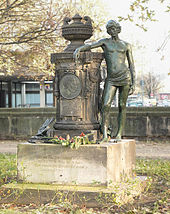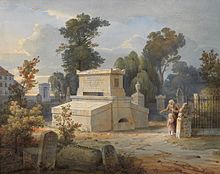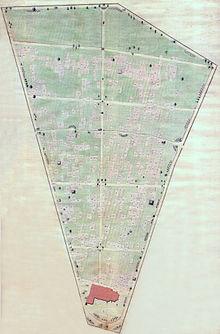Old St. Nikolai cemetery

The Old St. Nikolai Cemetery in Hanover is a historic cemetery that was laid out in the Middle Ages near the Nikolaikapelle and has served as a park since it was closed in the 19th century . The garden monument is located near downtown Hanover on Klagesmarkt and the Goseriede and has important grave monuments. One of the most beautiful is the memorial to the poet Ludwig Christoph Heinrich Hölty with a bronze statue of a grieving youth.
history


Copper engraving around 1740 by IG Schmidt after EE Braun , from Christian Ulrich Grupens Origines Et Antiqvitates
The St. Nikolai cemetery was laid out in the north of Hanover in the 13th century outside the city wall in front of the stone gate by the Nikolaikapelle. It was mentioned for the first time in 1284 as capella leprosorum extra muros (leprosy chapel in front of the city wall) while the first documentary mention of the cemetery was in a letter of indulgence issued in Avignon in 1355, which mentions burials in the area around the chapel. The Nikolaikapelle served as a chapel for the Nikolaistift, a hospital for lepers , and later a pen for impoverished women and girls. The cemetery was initially a burial place for the residents of the monastery, later, after the churchyard at the Marktkirche was abandoned, it was also the cemetery of Hanover's old town from the 15th century. It had to be expanded several times, including during a four-year plague epidemic from 1348. Even after that, the cemetery was densely occupied as a result of other plague epidemics, such as in 1428, 1566 and 1598. During the subsequent expansion in 1598, the cemetery was given a wall. Towards the end of the Thirty Years War there was overcrowding because of the many graves of soldiers, plague victims and deceased guarantors from Hanover, which led to a small expansion in 1657. Around 1740, the layout of the garden cemetery eased the occupancy.
Around 1780, the court architect Benjamin Hase designed a new cemetery wall made of sandstone blocks under a vaulted cover as part of the cemetery expansion, which has been partially preserved to this day.
There was a further expansion in 1783 and the last one in 1824. After the opening of the New St. Nikolai Cemetery in the north of the city ( An der Strangriede ), the St. Nikolai Cemetery was closed in 1866. In 1896/1902 the area was transformed into a park by city gardening director Julius Trip and in 1906 a “memorial courtyard”, which no longer exists today and which housed numerous valuable Renaissance grave monuments, was added to the Nikolaikapelle .
During the Second World War , the nearby Klagesmarkt bunker , but also the green area of the cemetery, protected some people from the raging firestorms in the city center during the air raids on Hanover .
In the post-war period , the former cemetery area was cut up in 1953 by the construction of a roundabout on Klagesmarkt and the continuation of Celler Strasse and reduced by a third. The remains of the Nikolaikapelle were demolished except for the choir. Of the 647 grave monuments before 1943, only 278 remained after the war, some of which were re-erected on the remaining area. In 1978, the former cemetery grounds were formally protected under the Lower Saxony Monument Protection Act , although the complex had been recognized as an object worth preserving for almost 100 years and was mentioned in a book on Hanoverian art monuments in 1871. Between 1996 and 2000, the area around the cemetery was redesigned. The Klagesmarkt to the southwest of the cemetery was traffic-calmed on one side and planted with plane trees on this side, the old transformer house was demolished and a new playground was created.
In addition to a historical overview of the history of the cemetery, a brochure from the City of Hanover's Green Space Office (see literature) also provides a list of 37 selected graves from the St. Nikolai cemetery. Their numbering is taken from the list below .
Renovation as part of Hannover City 2020+

As part of the inner-city renovation concept Hannover City 2020 + , the streets of Goseriede and Celler Strasse that ran through the cemetery after the Second World War have been partially reduced again since 2012. For the construction of a bicycle boulevard and a paved square, further construction work took place in November 2012 at the southern end of the cemetery area near the Nikolaikapelle, whereby improper excavation resulted in the opening of several graves and the uncovering of human bones. A previously unknown crypt at the Nikolaikapelle was destroyed and then filled with building sand.
After protests by citizens and critical reporting in the local press, the Lower Saxony State Office for Monument Preservation demanded an immediate construction stop and criticized serious planning errors. A continuation of the work was only permitted subject to conditions, which included the commissioning of a company specializing in archaeological work to accompany the further work. The exposed bones were reburied in a small ceremony.
In addition to the remains of the Nikolaikapelle , a number of gravestones from the Nikolaifriedhof were placed in the form of a lapidarium . Some of them are protected from falling over with the help of rectangular iron bars that are embedded in the ground and connected to the stones by round bars.
Funerary monuments (selection)



- Johann Heinrich Wedekind (1717–1787)
- Behrend Adolph Pape (1756–1791), master carpenter
- Caspar Christian Böhme (1701–1773), businessman
- Georg Christian Ludolph Meyer (1742-1812), Camerarius
- Wilhelm Blumenhagen (1781–1839), writer, and his wife Christine, b. Wiedemann (1782–1863)
- Wilhelm August Alemann (1728–1784), lawyer, councilor, mayor of the old town
- Johann Peter Danckert (1764–1829), Paying Commissair, and his wife Anna Dorothee Margarethe, b. Rettstadt (1783–1865)
- Friederica Maria Margaretha Theile, b. Muhdt (1772–1809)
- Sophie Magdalena Grove, b. Korb (1752–1824) and Johann Gottfried Wilhelm Grove (1770–1845)
- Johann Gottlieb Daniel Noltemeyer (1768–1849), church bailiff, and Wilhelmine Noltemeyer, b. Genger (1782-1862)
- Georg Christian Gottfried Schade (1761–1843), organist of the Marktkirche, and Anna Catharina Sophia Schade, b. David (1762-1834)
- Ernst August Landvoigt (1755–1823), gardener, and Maria Landvoigt, b. Rosenthal
- Andreas Wilhelm Hagemann (1745–1824), preacher at the Marktkirche
- Heinrich Wilhelm Maschmeyer (1787–1835), master coppersmith, and Catharina Louise Maschmeyer, b. Vieth (1805-1834)
- Georg Carl Andreas Wagner (1794–1854), royal Hanoverian court actor and theater manager.
- The father of August Friedrich Ludolph Schaumann , Otto Friedrich Schaumann (1747–1830), lawyer
- Carl Dietrich Mathée (1749–1835), businessman
- August Heinrich Andreae (1804–1846), architect and town builder
- Henriette Kohlrausch , b. Eichmann (1781–1842), widow of the Secret Chief Medical Councilor Dr. Heinrich Kohlrausch
- Johann Conrad Röhden (1720–1797), court butcher, and Margreta Eliesabeht Röhden, b. Canemann (1727–1796)
- Paul Gottlieb Werlhof (1699–1767), councilor and personal physician, and Sara Elisabeth Werlhof, b. Scriver (1709-1768)
- Heinrich Diederich von Anderten (1738–1816), Councilor, and his son Clemens Ernst Ludewig von Anderten (1772–1811)
- Johann Albrecht Grote (1720–1777), merchant and deacon of the market church
- Johann Friedrich Philipp Plener (1798–1864), senior building officer
- Anna Regina Schuster, b. Right (1843–1866)
- Johann Just Bartels (1722–1805), court gilder
- Ludwig Christoph Heinrich Hölty (1748–1776), poet. The location of the grave is unknown, instead the beautiful monument with the medallion portrait of the poet by Karl Gundelach (based on a contemporary silhouette) was erected in 1901 by the sculptor Otto Lüer . The memorial bears Nikolaus Lenau's memorial verses about Hölty: “Hölty, your friend spring has come. He is wailing wrong in the house to find you. But in vain, his plaintive reputation fades into lonely shadows. "
- Jean Joseph la Croix (1737–1828), Royal Fontainier (responsible for the fountains and water features in the Great Garden in Herrenhausen )
- Johann von Allwörden (around 1679–1736), Camerarius
- Denis Pilay (around 1638–1678), "decorator"
- Jeremias Sutel (1587–1631), sculptor
- Hans Hinüber (1618–1680), Princely Brunswick-Lüneburg postmaster of Hanover, and wife Justina Margaretha Hinüber, b. Meyer (1630–1687), wall painting on the choir of the Nikolaikapelle
- Anna Smidt, b. Meier (died 1584)
- Hans Hagen (1627–1716), master shoemaker, and Margaretha Hagen, b. Wietgrefe (1633–1697)
- Ludolf von Anderten (1562–1626), councilor, and Ilse von Anderten, b. von Wintheim (around 1577–1599)
- Christiane Juliane Wolckenhaaren, b. Eggers (d. 1737)
- August Theodor Roettiger (1766–1851), General, and Marie Anne Roettiger, b. Werningh (1773-1845)
- Carl Ludewig Vezin (Carl Ludwig Vezin; 1747–1805), merchant and Brunswick-Lüneburg mountain trader
Lost tombs



- Bartold Homeister († March 21, 1565 ), mayor of the city
- Bernhard Homeister (* around 1538; † July 13, 1614 ), Mayor of Hanover
- Georg Scharnekau (1505–1558), first Protestant preacher in Hanover
- Johann Ludwig Söhlmann (1797–1834), leather manufacturer in the August Söhlmann tannery, from 1833 in August Söhlmann Lederfabrik GmbH at Chausseestraße 100 (renamed Deisterstraße from 1855). In 1833 he used a steam engine for the bark mill and for the leather mill. His tomb is shown here .
- Grave stele of the family of the pastor of the Kreuzkirche Conrad Wecke ( Konrad Wecke ; 1528–1598) and Margarete Scheres and her children, erected in 1644
- Carl Anton Wilhelm Graf von Wedel (born June 6, 1790 in Magdeburg , † November 18, 1853 in Hanover), Hanoverian minister, member of the Council of State.
See also
literature
- Hanns Mahrenholtz : The grave inscriptions of the Hanoverian Nikolaifriedhof. In: Hannoversche Geschichtsblätter , New Series 9 (1956), pp. 1–125
- Claus Conrad: History of the St. Nikolai Friedhöfe , font as PDF document for Nikolai Stift, 2012. Retrieved on May 29, 2013.
- Anne Hufnagel, Michael Rohde: Nikolai cemetery. Garden monument preservation report on an abandoned cemetery in Hanover. 4. Project at the Institute for Green Planning and Garden Architecture at the University of Hanover. Hanover 1989.
- Anne Hufnagel, Michael Rohde: The Nikolai cemetery in Hanover. Garden monument conservation concept for an abandoned cemetery. In: Reports on the preservation of monuments in Lower Saxony . Vol. 10 (1990), pp. 7-13.
- Helmut Knocke , Hugo Thielen : Hanover. Art and culture lexicon. Handbook and city guide . 3rd, rev. Edition. Schäfer, Hannover 1995, p. 110.
- Ernst-August Nebig: Finally save the jewel Nikolaikapelle! No more debates and always new reports, action is required. In: home country . 2005, pp. 173-175.
- Arnold Nöldeke : The art monuments of the province of Hanover. 1: Hanover district. Issue 2: City of Hanover . Part 1: Monuments of the "old" city area of Hanover. Hanover 1932. (Reprint: Wenner, Osnabrück 1979, ISBN 3-87898-151-1 , pp. 251–255.)
- Waldemar R. Röhrbein : From Hanover's old cemeteries. In: Hans Werner Dannowski, Waldemar R. Röhrbein (Hrsg.): Stories about Hanover's churches. Studies, pictures, documents. Lutherhaus-Verlag, Hanover 1983, ISBN 3-87502-145-2 , pp. 97-102. (also about the St. Nikolai cemetery)
- Joachim Schmidt, Andreas Wawra: Hanover's ancient Nikolaifriedhof through the ages. In: German cemetery culture . Vol. 76 (1986), pp. 206-211.
- Michael Heinrich Schormann / Rainer Schomann / Friedrich-Wilhelm Wulf : The Nikolaifriedhof in Hanover, a place of historical interest. In: Reports on the preservation of monuments in Lower Saxony. 4/2013
- Henrike Schwarz (text), Silke Beck, Klaus Bonk, Klaus Helmer, Claudia Wollkopf (editor): The St. Nikolai-Friedhof and the Neustädter Friedhof , brochure of the state capital Hanover, Department of Environment and Urban Green , March 2003, p. 23 downloadable as PDF document
- Conrad von Meding: Can't you or don't you want to? In: Hannoversche Allgemeine Zeitung of November 24, 2012, p. 16
- Gerd Weiß , Marianne Zehnpfennig: Nikolaikapelle and Nikolaifriedhof. In: Monument topography of the Federal Republic of Germany , architectural monuments in Lower Saxony, City of Hanover, part 1, vol. 10.1 , ed. by Hans-Herbert Möller , Lower Saxony State Administration Office - publications by the Institute for Monument Preservation , Friedr. Vieweg & Sohn, Braunschweig / Wiesbaden 1983, ISBN 3-528-06203-7 , p. 57ff .; here: p. 58; as well as in the middle of the addendum to volume 10.2, list of architectural monuments according to § 4 ( NDSchG ) (excluding architectural monuments of the archaeological monument preservation ) / Status: July 1, 1985 / City of Hanover , p. 3ff.
- Helmut Zimmermann : Hölty received a "decayed burial". In: From the Steintor to Herrenhausen. Forays into Hanover's history. Verlag Ellen Harenberg-Labs, 1986, ISBN 3-89042-018-4 , pp. 16-21.
- Angelika Weißmann (text), Silke Beck, Nadine Köpper, Claudia Wollkopf (editor), Karin von Schwartzenberg (responsible): The former St. Nikolai cemetery. A garden monument in the center of Hanover , illustrated brochure (50 pages) with a historical outline and an annotated folding plan for historically significant tombs, ed. from the state capital Hanover, Department of Environment and Urban Greenery, Department of Green Areas - Central Tasks, Hanover: LHH, 2016; as a PDF document
Web links
- Conrad von Meding: Reconstruction of Goseriede / Bagger tears up graves at Nikolaifriedhof in the online edition of the Hannoversche Allgemeine Zeitung (HAZ) from November 18, 2012
- Bones found at the Nikolaikapelle are being investigated , photo series with comments by Conrad von Meding on the HAZ website
- NDR 1 Lower Saxony : Cemetery uncovered: Construction freeze on Klagesmarkt ( Memento from May 21, 2013 in the Internet Archive ) on the NDR's online page from November 21, 2012
- NDR 1 Lower Saxony: Bones in the excavator shovel ( memento from July 1, 2013 in the web archive archive.today ) on the ndr.de page from November 20, 2012
Individual evidence
- ^ Madelaine Pfeffer: About the Nikolai cemetery in Hanover. In: Hannoversche Geschichtsblätter , New Series, Vol. 60 (2006), pp. 291–313; here: p. 298; Preview over google books
- ↑ Hans Joachim Toll : Against the firestorm , in which: "If it had hit us ..." , in which: The night before the day without sun. A documentary report on the life and death of the city of Hanover , reprint of the documentary report, published in the Hannoversche Presse, Hanover: Hannoversche Druck- und Verlagsgesellschaft, [1953], p. 13
- ↑ Nikolaifriedhof / Bagger opens several graves in the city , in: Hannoversche Allgemeine Zeitung from November 19, 2012.
- ↑ State Office orders construction freeze on the Goseriede , in: Hannoversche Allgemeine Zeitung of November 20, 2012.
- ↑ Bones put to rest again , in: Hannoversche Allgemeine Zeitung of November 24, 2012.
- ↑ Angelika Weißmann: 24 Georg Carl Andreas Wagner , in Angelika Weißmann (text), Silke Beck, Nadine Köpper, Claudia Wollkopf (editor), Karin von Schwartzenberg (responsible): The former St. Nikolai cemetery. A garden monument in the center of Hanover , illustrated brochure (50 pages) with a historical outline and an annotated folding plan for historically significant tombs, ed. from the City of Hanover, Department of Environment and Urban Greenery, Department of Green Areas - Central Tasks, Hanover: LHH, 2016, p. 41 and others; as a PDF document
- ↑ Klaus Mlynek: SCHAUMANN, August…. In: Hannoversches Biographisches Lexikon , p. 310
- ↑ a b Grotefend, Fiedeler: Bernhard Hohmeister's notes on the history of the city of Hanover. In: Journal of the historical association for Lower Saxony , 1860, pp. 193–245; online through google books
- ↑ Sabine Wehking : DI 36, No. 111 † on the page inschriften.net , accessed on May 29, 2013
- ^ Jens Schmidt-Clausen: Scharnikau (Scarabaeus), Georg. In: Klaus Mlynek, Waldemar R. Röhrbein (eds.) U. a .: City Lexicon Hanover . From the beginning to the present. Schlütersche, Hannover 2009, ISBN 978-3-89993-662-9 , p. 537.
- ↑ Sabine Wehking: DI 36, City of Hanover, No. 341 †
Coordinates: 52 ° 22 ′ 43 " N , 9 ° 43 ′ 56" E


